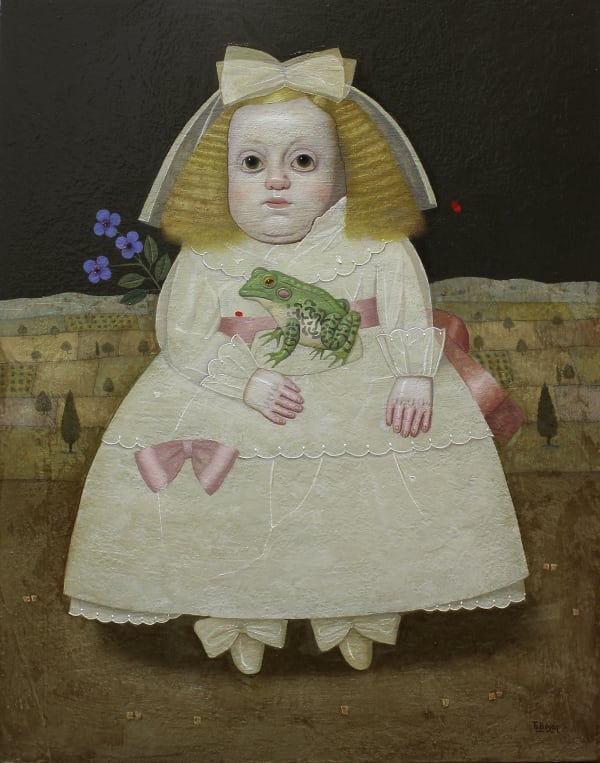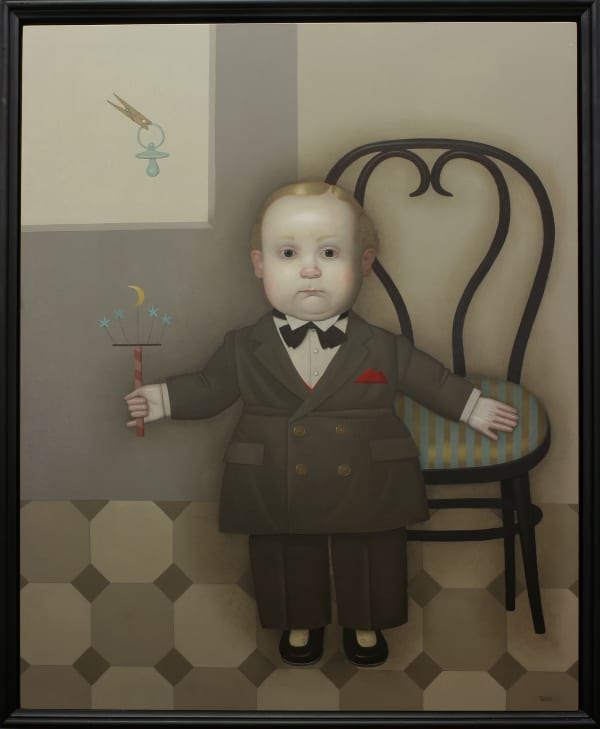My painting is the future playing with the past, pausing in the present. I offer only hints, leaving the final interpretation to the viewer. Each painting is a stage behind a door—an invitation to step inside, explore, and complete the story with one's own vision.
A self-taught painter with an early artistic vocation, Juan Fernández Béjar has shaped his style through meticulous direct observation and the study of the great European masters. His early work reflected a strong influence of the Spanish pictorial tradition, particularly the dramatic intensity appreciated by the Generation of '98.
By the late 1960s, his painting evolved into a personal synthesis of Expressionism and certain aspects of Surrealism, exploring unsettling and dreamlike themes. During the 1970s, he incorporated elements of orthodox Surrealism and developed a particular fascination with the decadence of Spain’s last Habsburg rulers, creating ghostly characters with a theatrical aesthetic and spectral faces.
From the 1980s onward, his work took on a more baroque and unsettling character, with a detailed realism that evokes both unease and irony. His mastery of drawing and his tendency to work in thematic series have solidified his singular trajectory within contemporary figuration, crafting an immersive atmosphere and a distinctive iconography.
-
 Juan BéjarBreve PausaOil on canvas46 x 38 cmView more details
Juan BéjarBreve PausaOil on canvas46 x 38 cmView more details -
 Juan BéjarDos puntos rojosOil on canvas46 x 38 cmView more details
Juan BéjarDos puntos rojosOil on canvas46 x 38 cmView more details -
 Juan BéjarLa mascotaOil on canvas46 x 38 cmView more details
Juan BéjarLa mascotaOil on canvas46 x 38 cmView more details -
 Juan BéjarLa nocheOil on canvas100 x 81 cmView more details
Juan BéjarLa nocheOil on canvas100 x 81 cmView more details -
 Juan BejarPasatiempoOil on wood100 x 81 cmView more details
Juan BejarPasatiempoOil on wood100 x 81 cmView more details -
 Juan BéjarSurpriseOil on canvas100 x 81 cmView more details
Juan BéjarSurpriseOil on canvas100 x 81 cmView more details
Juan Béjar was born in Málaga in 1946. In 1964, he traveled to Germany, where he lived in Nuremberg for several years. His artistic journey, deeply rooted in figuration, began to gain prominence in the early seventies, establishing him as one of the most distinctive painters of his generation. A relentless explorer of the human figure as an aesthetic emotion, Béjar has continuously evolved, maintaining a unique and deeply personal vision in his work.
In 1978, he was elected as a full member of the Real Academia de Bellas Artes de San Telmo, a prestigious honor he resigned from a year later. He was also a founding member of the Colectivo Palmo, a key avant-garde artistic movement in Málaga during the 1980s.
His extensive career is marked by numerous solo and group exhibitions across Spain and internationally, with shows in cities such as Pamplona, Málaga, Madrid, Barcelona, Gijón, Santander, Dresden, and San Salvador. His work has been featured in major fairs and galleries, including PAN Amsterdam, ART FAIR Den Bosch, Berliner Liste, and ARCO Madrid.
Béjar's paintings are held in significant public and private collections, including the Várez-Fisa Collection (Madrid), Helmut Brenske Collection (Hannover), the Pablo Ruiz Picasso Foundation (Málaga), the Museum of Fine Arts (Málaga), and the Museum of Modern Art in San Salvador.
His work, resistant to fleeting artistic trends, is founded on a masterful command of composition, drawing, and material. Far from arbitrariness, his paintings exude originality and creative energy. His figures, imbued with poetic and melancholic expressions, refuse to conform to reality. Like Proust's literary quest to recover lost time, Béjar’s paintings seek to rediscover a forgotten vision of the world—an image of dreams, instinct, and sensory communication.
His universe, reminiscent of De Chirico’s enigmatic cityscapes, balances a tension between escape and longing, serenity and turmoil, irony and sorrow. Wrapped in an indefinable atmosphere, his paintings resonate with metaphorical depth, evoking a dialogue between memory and imagination.
(Miguel Ramos Morente, Culture Manager and Art Critic)









